Related Research Articles

Year 1572 (MDLXXII) was a leap year starting on Tuesday of the Julian calendar.
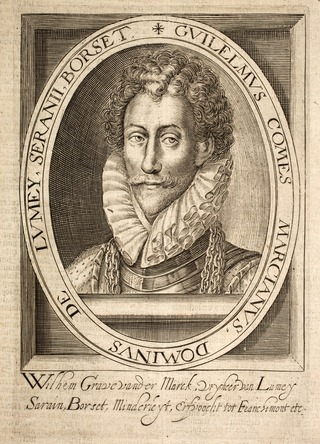
William II de la Marck was the Lord of Lumey and initially admiral of the Watergeuzen, the so-called 'sea beggars' who fought in the Eighty Years' War (1568–1648), together with among others William the Silent, Prince of Orange-Nassau. He was the great-grandson of an equally notorious character, baron William de la Marck, nicknamed the "wild boar of the Ardennes".

José Luis Sánchez del Río was a Mexican Cristero who was put to death by government officials because he refused to renounce his Catholic faith. His death was seen as a largely political venture on the part of government officials in their attempt to stamp out dissent and crush religious freedom in the area. He was dubbed "Joselito."

The Forty Martyrs of England and Wales or Cuthbert Mayne and Thirty-Nine Companion Martyrs are a group of Catholic, lay and religious, men and women, executed between 1535 and 1679 for treason and related offences under various laws enacted by Parliament during the English Reformation. The individuals listed range from Carthusian monks who in 1535 declined to accept Henry VIII's Act of Supremacy, to seminary priests who were caught up in the alleged Popish Plot against Charles II in 1679. Many were sentenced to death at show trials, or with no trial at all.

Fidelis of Sigmaringen, OFMCap was a Capuchin friar who was involved in the Catholic Counter-Reformation, and was martyred by his opponents at Seewis im Prättigau, now part of Switzerland. Fidelis was canonized in 1746.
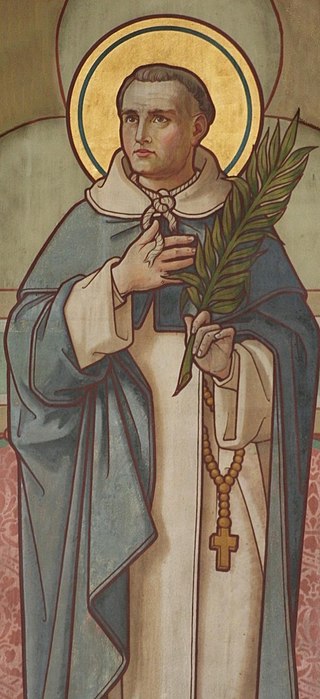
John of Cologne, was a friar and priest of the Dominican Order, born in the Electorate of Cologne, part of modern Germany. He later became a parish priest of Hoornaar, in the Spanish Netherlands. He was executed for his faith in 1572 and has been declared a martyr and saint by the Catholic Church.
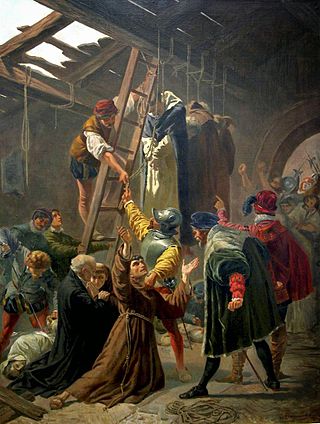
The Martyrs of Gorkum were a group of 19 Dutch Catholic clerics, secular and religious, who were hanged on 9 July 1572 in the town of Brielle by militant Dutch Calvinists during the 16th-century religious wars—specifically, the Dutch Revolt against Spanish rule, which developed into the Eighty Years' War.

Devasahayam Pillai or Mar Lazarus Sahada was an Indian layman and martyr of the Catholic Church. He was canonized as a saint of the church by Pope Francis on 15 May 2022.

Nicholas Pieck, O.F.M., "Nicolaas" or "Claes Pieck" in Dutch, was a Franciscan friar who was one of a group of Catholic clergy and lay brothers, the Martyrs of Gorkum, who were executed for refusal to renounce their faith in 1572.
This page is an index of lists of people considered martyrs. A martyr is someone who suffers persecution and death for advocating, renouncing, refusing to renounce, or refusing to advocate a belief or cause as demanded by an external party. This refusal to comply with the presented demands results in the punishment or execution of the martyr by the oppressor.
During the Spanish Civil War Catholic people faced persecution from the Republican faction of the war, in part due to their support of the nationalists and the recently abolished monarchy. The Catholic Church venerates them as martyrs. More than 6,800 clerics and other Catholic people were killed in what has been dubbed the Red Terror. As of November 2023, 2,127 Spanish martyrs have been beatified; 11 of them being canonized. For some 2,000 additional martyrs, the beatification process is underway
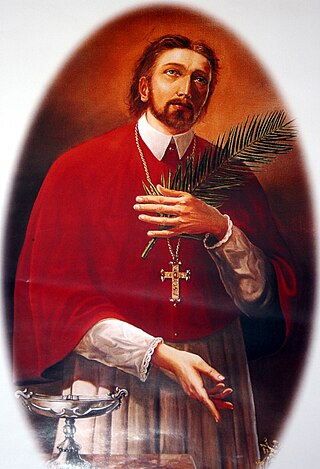
Marko Stjepan Krizin, or Marko Križevčanin was a Croatian Roman Catholic priest, professor of theology and missionary, who was active in the 17th century. In the course of the struggle between Catholicism and Calvinism in the region then, he was executed for his faith. He has been declared a saint by the Catholic Church, the third Croat to be so honored.
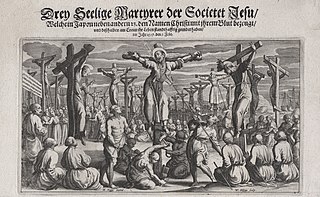
The Martyrs of Japan were Christian missionaries and followers who were persecuted and executed, mostly during the Tokugawa shogunate period in the 17th century. More than 400 martyrs of Japan have been recognized with beatification by the Catholic Church, and 42 have been canonized as saints.

The Carthusian martyrs are those members of the Carthusian monastic order who have been persecuted and killed because of their Christian faith and their adherence to the Catholic religion. As an enclosed order the Carthusians do not, on principle, put forward causes for their members, though causes have been promoted by others on their behalf.

The Martyrs of Natal were a group of 30 Roman Catholic people of Colonial Brazil – two of them priests – killed in the northern part of the colony in massacres that a large group of Dutch Calvinists led. One priest was a Colonial Brazilian Jesuit missionary, while the other priest was an evangelizer himself. The others were all lay Catholics, most of them anonymous members of the Church, some of them children.

Manuel Moralez was a Mexican layman who was killed during the Cristero War. A pro-Catholic activist during the anticlerical period under President Plutarco Elías Calles, he was captured by government forces, and was executed for refusing to renounce his position. Moralez was canonized by Pope John Paul II on 21 May 2000 as one of 25 Saints of the Cristero War.

André de SoveralSJ was a Portuguese-Brazilian Catholic priest and martyr, killed during the Restoration War at the Martyrdom of Cunhau, a massacre promoted by Dutch troops and their Calvinists Protestant elders, who fought against the Portuguese Empire in Brazil. Soveral was canonized in 2017 by Pope Francis along with 29 fellow martyrs.

Godfried Coart {Godfried van Melveren} was a Franciscan friar and one of the martyrs of Gorkum. He is honored as the first canonized saint of Belgium.

Anthony of Weert was a Franciscan friar and priest who was martyred during the Dutch Revolt. Eighteen other men were martyred alongside him; they are known as the Martyrs of Gorkum.
The Martyrs of Roermond were a group of 13 Dutch Catholic clerics, secular and religious, who were murdered on 23 July 1572 in the town of Roermond by militant Dutch Calvinists during the 16th-century religious wars—specifically, the Dutch Revolt against Spanish rule, which developed into the Eighty Years' War.
References
- ↑ "CATHOLIC ENCYCLOPEDIA: The Martyrs of Gorkum". www.newadvent.org. Retrieved 2021-06-01.
This article needs additional or more specific categories .(June 2021) |